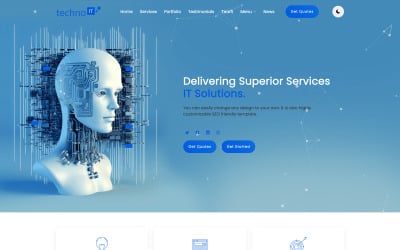Unique Website Design Solutions for Business Websites
Wiki Article
Top Tips for Developing an Impactful Site Style That Converts
In today's digital landscape, the importance of an impactful site layout can not be overstated, particularly when it pertains to transforming visitors into customers. To achieve this, one need to think about a selection of aspects, consisting of recognizing the target market, focusing on customer experience, and maximizing for mobile systems. In addition, the tactical use engaging call-to-actions and a distinct visual power structure plays a crucial function in guiding customers with their journey. As we check out these important aspects, it ends up being obvious that the success of your website rests on greater than simply appearance; it requires a thoughtful strategy to layout and functionality.
Understand Your Target Market
Recognizing your target market is essential to effective web site layout, as it lays the foundation for developing an engaging individual experience. Recognizing who your customers are, including their demographics, choices, and habits, enables designers to tailor the web site's material, design, and capability to meet details needs.Conducting detailed market study is essential in this process. Studies, interviews, and analytics can offer useful understandings into user expectations and pain factors. By assembling this information, designers can develop individual characters that stand for different sectors of the target market, ensuring that design choices are notified and appropriate.
Furthermore, recognizing the target market assists in selecting ideal design elements such as shade plans, typography, and images that reverberate with customers. An internet site that talks straight to its audience promotes a sense of link and count on, motivating longer check outs and higher conversion rates.
Eventually, a user-centered strategy to website layout not only improves individual contentment yet likewise sustains organization goals by driving engagement and loyalty. By prioritizing the needs and choices of the target audience, a web site can efficiently offer its purpose and achieve wanted outcomes.
Prioritize User Experience
To boost the overall efficiency of a site, prioritizing customer experience (UX) is vital (Website Design). A well-designed UX makes certain that site visitors can browse the website effortlessly, locate information rapidly, and engage with content meaningfully. This brings about enhanced individual fulfillment and higher conversion pricesBegin by implementing instinctive navigation. Menus needs to be logically structured, enabling individuals to locate key locations of the website with marginal initiative. Consistency in layout elements, such as shade schemes and fonts, cultivates experience, which is vital for maintaining customer interaction.
In addition, consider the packing speed of your website. A hold-up of just a couple of secs can cause considerable drop-offs, as users are less likely to wait for a slow-loading web page. Improving photos and optimizing code can enhance efficiency and maintain site visitors.
Furthermore, quality in content discussion is essential. Usage concise, appealing language and damage up message with visuals to improve readability. By prioritizing customer experience, you not only create a much more enjoyable atmosphere for visitors but additionally strengthen your brand name's trustworthiness. Ultimately, an emphasis on UX is an investment in the lasting success of your site.
Optimize for Mobile Devices
Optimizing for smart phones is essential in today's digital landscape, where an increasing variety of individuals accessibility internet sites via smart devices and tablets. A mobile-friendly layout not just boosts customer experience but also plays a significant role in improving internet search engine rankings. To attain this, it is important to adopt a responsive style that immediately changes to various screen dimensions and alignments.
Loading rate is another critical aspect; mobile users are normally less person and expect rapid access to information. By focusing on mobile optimization, you guarantee that your website stays affordable and properly engages a wider audience.
Use Engaging Call-to-Actions
An internet site's effectiveness commonly rests on its capacity to guide visitors towards wanted actions, making engaging call-to-actions (CTAs) essential components of design. visit site CTAs offer as the pivotal points that guide individuals to involve with the website, whether that indicates buying, authorizing up for an e-newsletter, or downloading and install a source.To create reliable CTAs, clearness is paramount. Use succinct language that plainly communicates the action you desire the user to take.
Furthermore, the design of CTAs need to attract attention without being interfering. Use contrasting colors and clear font styles to guarantee they catch attention. Furthermore, think about utilizing directional cues, such as arrowheads or images, to guide individuals toward these buttons. By concentrating on these components, organizations can substantially enhance customer involvement, driving conversions and eventually achieving their website's objectives.
Focus on Visual Power Structure
Efficient site layout relies greatly on a well-structured aesthetic hierarchy that overviews users with content seamlessly. By arranging elements in a way that focuses on details, designers can boost user experience and assist in decision-making. This includes utilizing dimension, color, comparison, and spacing strategically to accentuate one of the most crucial elements of a page.Making use of larger typefaces for headings and subheadings develops a clear difference between different areas, enabling individuals to check material effortlessly. Additionally, utilizing contrasting shades for switches and calls-to-action can capture user interest and encourage interaction. Whitespace is an additional vital component; it prevents clutter and enables users to concentrate on crucial messages without distractions.
Images and graphics must match the text while also sticking to the well-known power structure, enhancing the overall message (Website Design). Uniformity in style elements, such as color design and typography, additional enhances the visual hierarchy, making navigation instinctive

Conclusion
In verdict, efficient site style necessitates a comprehensive understanding of the target market, prioritization of customer experience, and mobile optimization. The critical my explanation usage of navigate to these guys compelling call-to-actions and a distinct aesthetic hierarchy additionally improves individual interaction. By implementing these principles, web sites can attain higher conversion prices, guaranteeing that style components not just draw in site visitors however likewise promote seamless navigation and interaction. Eventually, a well-executed site design works as a crucial component in driving customer actions and achieving service purposes.Report this wiki page